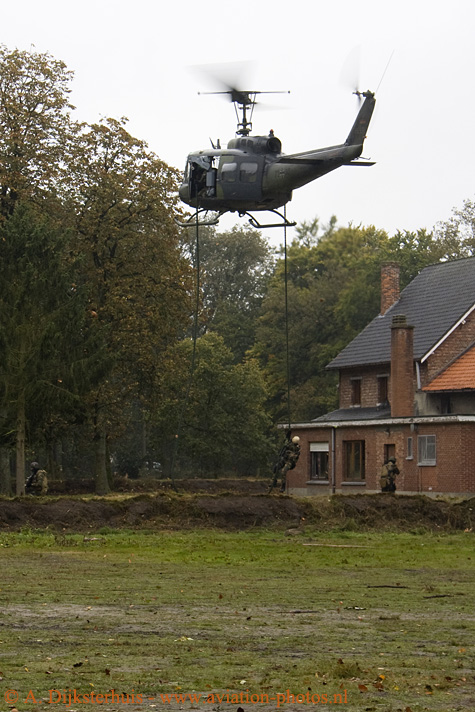|
|
|
|
Green Blade/Pegasus exercise 2012
|
|
The Belgian Air Component, ably supported by Luxembourg, hosted the joint and combined helicopter training and Special Forces 2012 exercise, Green Blade/Pegasus, at the Kleine Brogel Air Base, Belgium in October. The exercise was hosted by the EDA (European Defence Agency) Helicopter Training Programme. Kleine Brogel Air Base is the home of the 10th Tactical Fighter Wing. This Air Base served as a Deployed Operating Base (DOB) for both the Green Blade exercise and that of Pegasus. Pegasus 2012 relied on using the helicopter as part of their training. Combining both exercises into one not only offered the right training opportunities for both helicopter crews and Special Forces, but also had the
effect of reducing costs, both a good example of the pooling and ‘sharing’ concept of the European Defence Agency and saved a lot of tax-payers money during these difficult financial times. |
|
|
| |
 |
|
| |
Pegasus
Pegasus 2012 was organised by the Belgium Special
Forces Group and is a biennial exercise with an international
character. Special Forces from Belgium (21st
Company 3rd Parachute Group from the Special Forces
Group in Heverlee), Italy (IX Battaglione “Col
Moschin” in Livorno) and Spain (Escuadrón de
Zapadores Paracaidistas in Murcia and Fuerza de
Guerra Naval Especial in Cartagena) gathered at Kleine
Brogel, Belgium. The commander of the Special
Operations, Lieutenant Colonel Tom Bilo; “A combined
exercise like Green Blade and Pegasus gives a very
good opportunity to the task groups from different
countries to train and to cooperate with task groups
from other countries. A lot can be learned by just coming
together and sharing the experiences. With this
combined exercise, a unique and challenging opportunity
is offered to the special forces to train and to improve
their tactics, techniques and procedures while also training
with allied Task Groups and improving the interoperability
using rotary and fixed wing assets. Last but not
least, as an international exercise, Pegasus also fosters comradeship between the different nations and communities”. |
|
| |
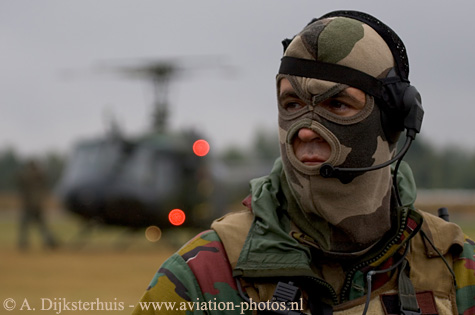 |
|
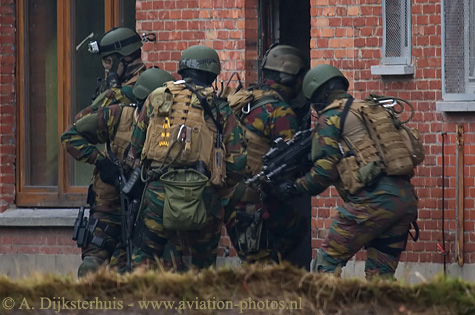 |
|
| |
Green Blade
The Green Blade exercise had three objectives: To
enhance the interoperability at the tactical level in a
realistic and challenging environment, to manage the
deployment of the helicopter units and to conduct operations
in a multinational environment.
About 550 personnel and fifteen helicopters arrived
at Kleine Brogel on Monday 17 September. Host nation
Belgium took part with five Agusta A.109BA “Hirundo” utility helicopters from 1 Wing which is
based at Beauvechain. Transporthubschrauberregiment
30 (THR30) from the German Army (HEER) arrived
with six UH-1D Hueys from their homebase
Niederstetten, Germany. The Aviazione dell’Esercito
Italiano (Italian Army) participated with two types of
helicopters, a pair of Agusta A.129C Mangusta attack
helicopters and two CH-47C Chinook transport helicopters.
The A.129C Mangusta helicopters are operated by
5° Reggimento “Rigel”, based at Casarsa della Delizia
(located North-East of Venice), while the Chinook helicop-ters
came from Viterbo (North of Rome), Italy and
are assigned to 1° Reggimento “Antares”.
The exercise followed a ‘step by step’ approach using
three different modules while increasing the complexity
of the missions.
In the first week the participants familiarised themselves
with the exercise area, the equipment and procedures
of the other foreign units as part of the Combat
Enhancement Training/Force Integration Training
(CET/FIT) phase. On Tuesday 18 September, familiarisation
briefings and flights were made to make the
Special Forces familiar with the dif-ferent types of helicopters
and the procedures for boarding and disembarking
in a safe way. Pinpoint navigation flights were made
over the provinces of Antwerp, Liége, Limburg and
Namur to make the aircrew familiar with the landscape,
local flight rules and exercise specific op-erating procedures. Non tactical training flights including night flying
with Night Vision Goggles (NVG) and Nap of Earth flights were made as well. Workshops were given on a
variety of subjects like Medics, Forward Air Controller
(FAC)/JTAC (Joint Terminal Attack Controller),
Communications, Sniping, Tactical Site Exploitation
and demolitions.
|
|
| |
The Special Forces practiced free fall
parachute jumps from a C-130H Hercules of the
Belgian Air Component, shooting, balloon jumping and
practiced Fast Roping and SPIE Rig (Special Purpose
Insertion/Extraction Rig) extractions, both day and
night. Fast-roping is a technique to deliver personnel
from a helicopter onto places that a helicopter can not
land on or is too restricted for a safe low level hover.
The forces quickly descend on by one using a thick
rope. This technique was developed by the British and
first used in combat during the Falklands war. The
SPIE Rig was developed by the US Marines to insert
or extract personnel rapidly while wearing a harness
with a carabiner. The descenders hook up to a D-ring
on the SPIE rope and secure themselves with a second
safety line. The helicopter climbs vertically until the
rope and personnel are clear from obstacles, and the
helicopter will proceed in forward flight. The crosstraining
with the Special Forces started from Sanicole,
a small airfield near the Leopoldsburg Barracks, close
to Kleine Brogel Air Base.
During the next two weeks, the Field Training
Exercise section took place. In the second part of the
exercise, the units had to analyse, plan and execute a
wide variety of Special Operations Forces related missions
such as insertion, extraction, hostage rescue, personnel
recovery and on request also the more traditional
helicopter missions such as airmobile operations,
MedEvec, Recce and Surveillance flights. Direct
actions, such as the capture of High Value Targets
(HVT) and Hostage Release Operations (HRO) were
practiced, combined with platoon size raids, Tactical
Air Land Operations, Medevac/Casevac, Close Air
Support and Close Combat Attack missions. F-16s
from Kleine Brogel also participated in this part of the
exercise) using a Forward Air Controller or a Joint
Terminal Attack Controller. Personnel Recovery
(CSAR, Combat Search and Rescue). This was demonstrated
by an Italian A.129 Mangusta when the‘downed’ crew was evacuated while sitting on the
undercarriage of the main landing gear.
The nature of the missions in the third part of the
exercise were similar to the previous one, but the helicopters
were temporarily deployed to a Forward
Operating Base (FOB) in the south-east of Belgium.
The FOB also operated as a Forward Arming and
Refuelling Point (FARP) point during the this part of
the exercise. |
|
|
| |
Helicopter Life closely witnessed one of the operations in a simulated scenario. In this scenario a radical revolutionary group is active and is terrorizing the local population and is kidnapping people with an increasing number of civilian casualties each day. An
International Security Force has been mandated to intervene. Human Intelligence (HUMINT) and Signal Intelligence (SIGINT) indicated that the leader of this radical group is using a house in the woods as a hideout. The leader was identified as a High Value Target (HVT) and a Belgian Special Operations Task Unit had been ordered to capture the leader alive. The planning and preparation started and is supported by a combined Rotary Wing Special Operations Air Task unit.
|
|
| |
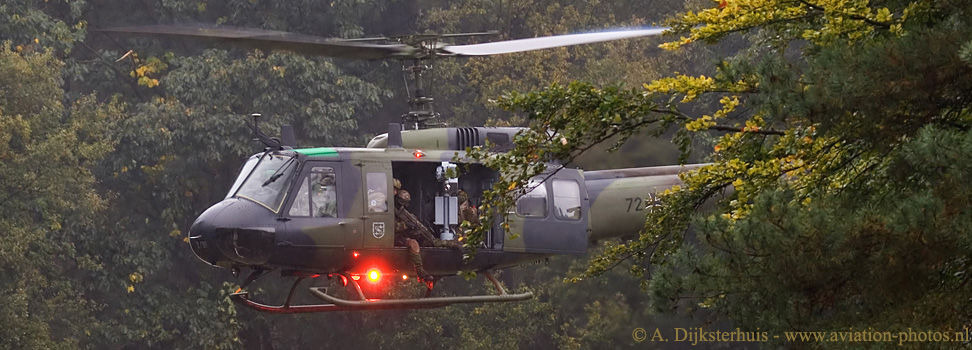 |
|
| |
Four phases can be recognized during the mission; Clear and secure, insertion of the assault and diversion force, extraction of the assault force and extraction of the diversion and cordon force. The target is observed by a Special Reconnaissance team for two days to identify his pattern of life. Their observations showed that the target was present in the house and based on this info, the Special Operations Commander decided to execute the pre-planned mission
in order to capture the target alive. Just before dawn a platoon of the Special Forces Group were dropped by parachute in order to secure the perimeter of the target. Just minutes before the start of the mission, a F-16 equipped with a sniper pod, flew overhead the target to provide the Joint Terminal Attack Controller with the latest situational awareness needed to guide and control the helicopters during the mission. The information from the reconnaissance F-16,
together with the information from the Special Reconnaissance team confirms that most of the insurgents, including the target, are in the house and that one armed vehicle is patrolling in the surrounding.
|
|
| |
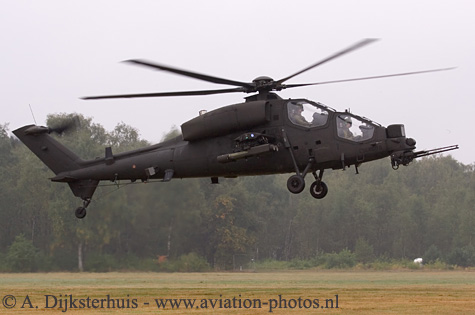 |
|
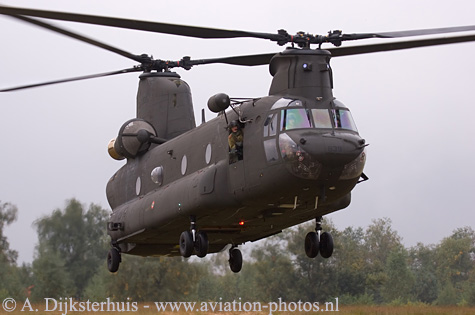 |
|
| |
After a correct read back of the coordinates the JTAC contacts the COBRA formation, consisting two Italian A.129 attack helicopters, that “the High Value Target (HVT) is localized in a house in grid Fox Sierra six zero eight three six three four eight. We spotted an enemy vehicle with a heavy machine gun in grid Juliet Four. You are approved for the attack after a PID, how copy?” Cobra45 responds; “Juliet Four, clear to run in, Cobra45”. Seconds later the sound of rotor blades is swelling and an Italian A.129 comes behind the trees for its first run. “Cobra45, this is Dagger, confirm you are on the target”. “Confirmed, we are on the target, hold on” is followed by a pair of explosions. After the vehicle is destroyed, this is reported to the COBRA flight and they are instructed by the JTAC to fly overhead and to provide top cover. ‘BEAST55’ is contacted by the JTAC and approved to approach for the target area and is cleared to land to the north-west of the house. One minute later, the Italian Chinook pops up behind the trees to insert the diversion force by fast rope to attract and fix the insurgents on the west side of the house. In the mean time the HUSKY formation is prepared to fly in for the insertion of the Assault Force. One minute later, the Chinook leaves. Within twenty seconds, the first of two UH-Ds is hovering on the southeast side of the house, delivering the Assault Force by fast rope. Their task is to force their way into the house by breaching the door and also to the capture the target.
|
|
| |
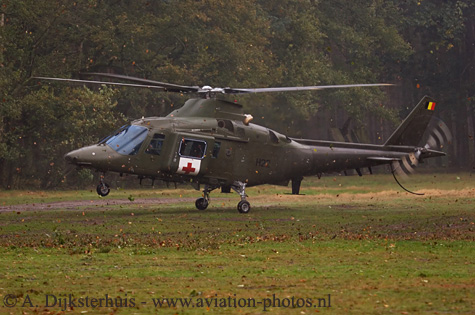 |
|
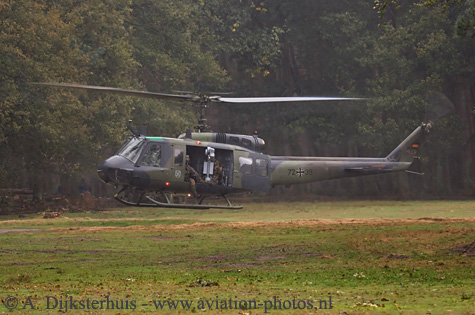 |
|
| |
One team member was injured during the assault and “Samaritan60” was contacted to evacuate the injured team member. A few minutes later, a pair of A109BA helicopters arrive on the scene. The first helicopter lands while the second one provides top cover with the machine gun installed. After the departure of the Medevac helicopter, the UH-1Ds returns to pick up the captured leader and the Assault Force. Both helicopters depart as quickly as they arrived. In the mean time the Diversion Force is returning to the extraction zone with the swelling sound of the Chinook in the background. One minute later, the Italian Chinook is on the ground ready to extract all the remaining soldiers. After take off the quietness of the woods returns as though nothing had happened.
|
|
| |
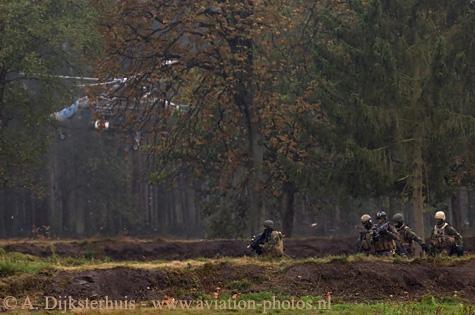 |
|
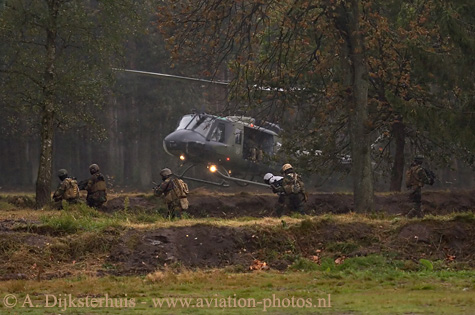 |
|
| |
After three weeks, 49 missions and 487 flying hours later, the participating helicopters and ground forces left Kleine Brogel Air Base for their home base. Andy Gray, in charge of the Helicopter Training Programme of the EDA said; “we have to train the personnel the way we fight. Collaboration is the only option and Green Blade is an excellent example of how far we get by working and training together”. Everybody made a tremendous effort and delivered on time. The exercise objectives were reached, exceeding initial expectations. Operational experiences were exchanged and lessons learned were shared. The capabilities were enhanced through a better mutual understanding and the level of interoperability increased.
|
|
| (c) Arjan Dijksterhuis, the Netherlands, 2002-2013 |





